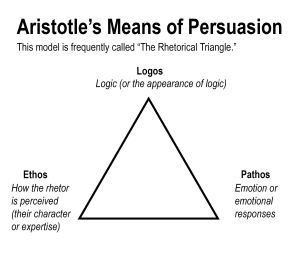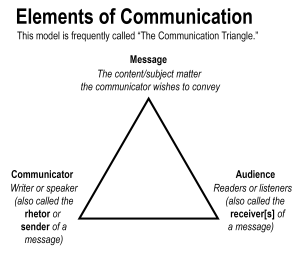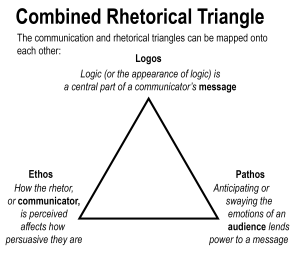5 Understanding the Means of Persuasion
Melissa Elston
Learning Objectives:
- Identify some basic rhetorical methods and strategies an author may use to make an argument
- Recognize how these strategies overlap with elements of communication
The last chapter mentioned something called the “means of persuasion.” Here, you can explore some of the basics of Aristotelian theory, as well as how they compare to our more modern understandings of communication and argument.
An Early Model: The Rhetorical Triangle
Aristotle was a thinker who lived in the 300s B.C.E. — before the common Era — in ancient Greece. He wrote treatises on subjects ranging from math to biology to politics to poetry, but what we remember him for in writing and communication studies is his contribution to the field of rhetoric.
Aristotle was interested in audiences. More specifically, he wanted to know how they could be analyzed, approached, and hopefully persuaded to see things from a speaker’s point of view. After some reflection, he theorized three main ways in which people can be persuaded, and this model, which we will call the rhetorical triangle (or second rhetorical triangle), is still widely used in the West today.
The first way Aristotle suggested audiences can be moved is through logos. Logos is commonly understood as logic — or at least, the simulation of logic. Here is the tricky thing about logos: It simply means reasoning. In Aristotle’s model, reasoning doesn’t have to be correct to work on audiences; it only has to sound like it is or could be correct. When you go to write papers, most professors expect to see sound reasoning backed by facts and data. But any rhetorical study of political speeches, advertisements, and the like will demonstrate that speakers and writers can use faulty reasoning, or numbers and data out of context, and still persuade audiences. This is something that you should be aware of, as you move through the world.
The second way Aristotle suggested audiences can be moved is through pathos, which we typically define as an emotional appeal. These, too, play a role in decision making. Fear, love, hatred, sadness, even boredom can all drive human behavior. In Aristotle’s formulation, reading an audience’s mood or emotional state and appealing directly to it — or attempting to shift or create alternate emotions — can make a speaker or writer more effective. A speaker or writer can even sometimes override logos (or convince folks that faulty logos is stronger than it is) if they work on the audience’s emotions.
The third way audiences can be moved, in Aristotle’s model, is something called ethos. English speakers often imagine that the word ethos means “ethics,” but this is a false cognate. What Aristotle actually was describing is reputation: an audience’s impression of the person writing or speaking to them. Ethos can certainly stem from a person’s perceived character. (This is the closest approximation in English of Aristotle’s terminology here!) But it can also stem from a person’s similarities with audience members (perhaps the audience finds them relatable), or a stereotype an audience holds about certain types of people. Ethos can also stem from a person’s fame, expertise, or notable achievements. This is why celebrity endorsements in commercials work so well. The ad-makers are betting that the celebrity’s persona is going to somehow transfer to the audience’s associations with the product, and they will find that association persuasive enough to want to buy what the celebrity is selling.
So, to summarize: ethos, pathos and logos are Aristotle’s means of persuasion. Together, they are frequently called the rhetorical triangle. As time has gone on, scholars have theorized additional types of appeal. For example, M. Jimmie Killingsworth’s Appeals in Modern Rhetoric lists an entire host of additional appeals: appeals to the body and its needs, like hunger or sex; appeals to gender and one’s sense of it; appeals to geographic place. Therefore, Aristotle’s model can be complicated somewhat. However, ethos, pathos, and logos are a common starting point for most students. They are simple and cover a lot of persuasive ground.

A Second Model: The Communication Triangle
Aristotle’s triangular model is actually one of two triangular diagrams that writing and communication experts often use. In many modern college-level speech and writing courses, instructors also frequently refer to something called the Communication Triangle. This second model (pictured below) simply provides a breakdown of the parts of a communication act, which can include — but is not limited to — acts of persuasion.
In order for a communication act to occur, you need:
- A communicator: the writer or speaker. They are also sometimes called the rhetor or sender.
- A message: something the writer or speaker wishes to communicate.
- An audience, either real or imagined: this is the person or the people who the author is writing to. They are also sometimes called the receiver(s).
All three elements of this triad are interrelated: a savvy communicator tailors the message to their audience. This means the communicator considers the audience’s interests, values, wants/needs, and other characteristics as they speak or write.
An audience’s size can be an important consideration as well. Some communication acts have a very narrow audience. For example, if you write a private message online to a friend, your imagined audience is one person. On the other hand, if you engage in a broader act of communication — a Facebook wall post, a public speech, a published article or essay — your audience becomes a lot bigger (and their characteristics more diverse). A broader audience also can be subdivided into multiple audiences. For instance, the people reading a Facebook wall post can be described, on a whole, as people on the communicator’s “friends list,” but it can also be subdivided into multiple audience groups: Real-life friends (vs. online-only friends), family members, former high school classmates, former teachers, present-day co-workers. Each of these groups has a certain set of expectations. You probably keep in touch for different reasons. The type of relationship you have (examples: familial, social, professional) helps shape those reasons, and the types of information and interactions that you expect from one another. So depending on who the wall post is visible to, you may be juggling different audiences, and weighing how each one of them will interpret the post as you write it.
If you use Facebook’s settings to limit the audience on particular posts, congratulations! You are probably already working with an intuitive understanding of the rhetorical situation in the Communication Triangle model.
The figure below diagrams the delicate balance between communicator, message, and audience:

A Combined Model
Finally, one important thing to recognize about Aristotelian and communication theory is that the models overlap. It is easy to describe ethos as a type of appeal that is largely dependent upon the communicator in any rhetorical situation. Similarly, you can map pathos onto audience (as it depends upon an audience’s emotional state), and logos onto message (as the construction of logic happens within the text itself). An example of this type of dual mapping can be seen below:


